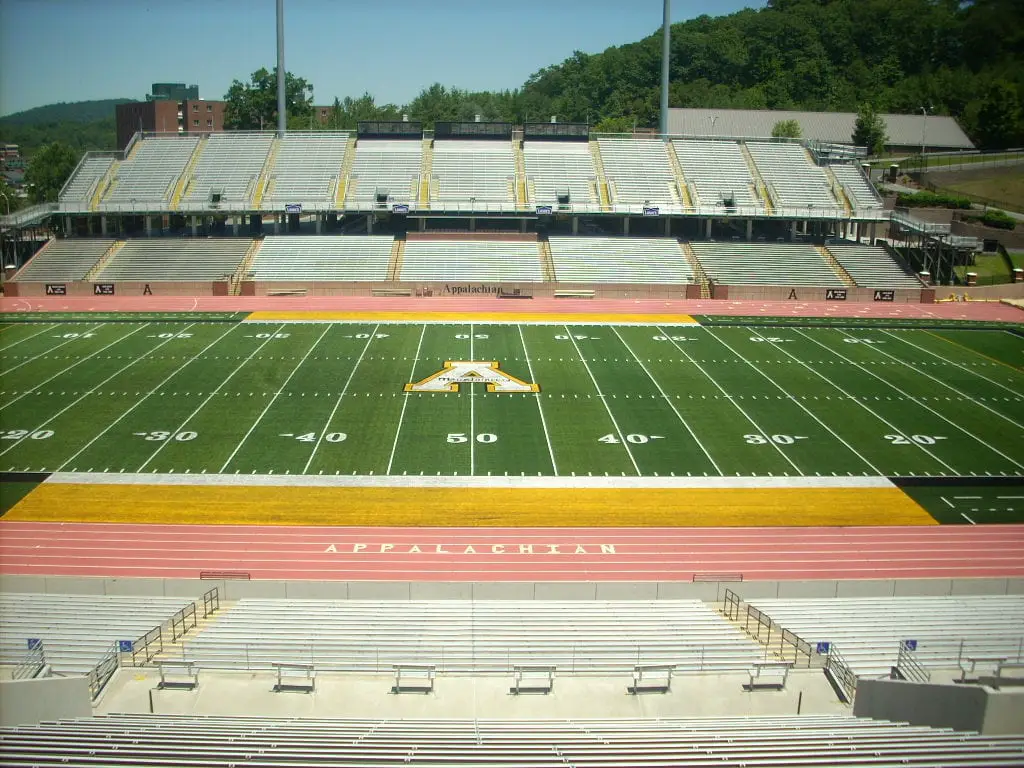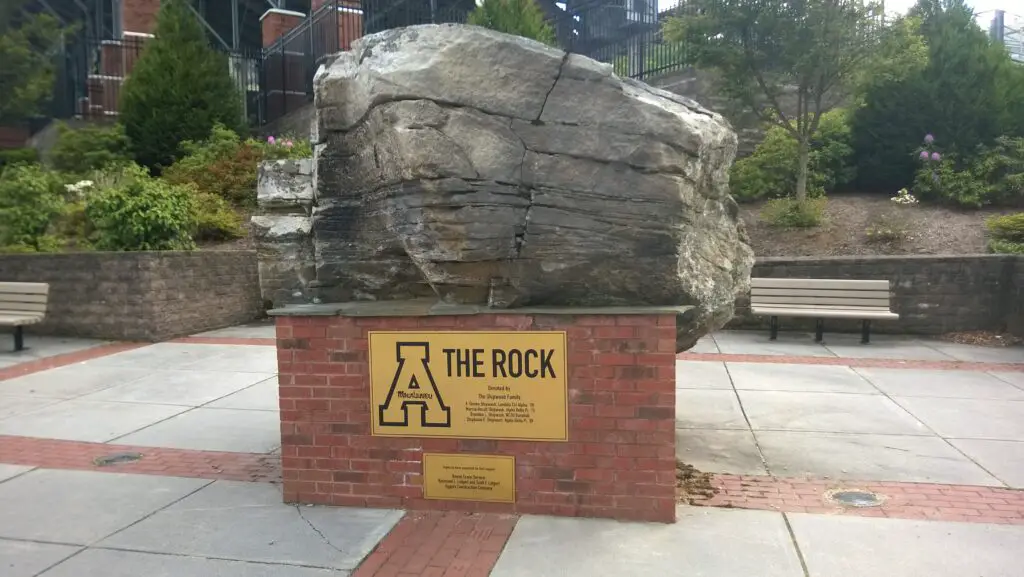The Early Days of Kidd Brewer Stadium: Conrad Stadium
In the crisp mountain air of Boone, North Carolina, the year 1962 brought with it the echoes of cheering fans and the rumble of determined athletes taking to the field. Conrad Stadium, named in honor of William J. Conrad, an esteemed university trustee, and R.J. Reynolds executive, was officially opened on September 15.
With its 10,000 permanent seats, it was a beacon of progress, replacing the revered College Field where Appalachian State University’s football games had been played since 1928.
Conrad Stadium was a groundbreaker in its own right. It was the first venue in either North or South Carolina to feature artificial turf, setting a new standard for sporting grounds in the region.
The first game on this novel surface was held on October 3, 1970, between the Mountaineers and Elon. This marked a significant milestone in the Carolinas’ sporting history.
By the end of the 1978 season, the stadium had expanded its seating capacity to 18,000. This expansion paved the way for it to serve as the backdrop for the second-ever college football game televised by ESPN, a momentous occasion for the Mountaineers as they competed against the Western Carolina Catamounts for the Old Mountain Jug.
Renaming to Kidd Brewer Stadium and Major Achievements
September 3, 1988, brought a new chapter in the stadium’s history. In honor of Kidd Brewer, one of Appalachian football’s most successful head coaches, Conrad Stadium was renamed.
A native of Winston-Salem, Brewer left an indelible mark on the Mountaineers during his four seasons as head coach from 1935 to 1938. His record of 30 wins, five losses, and three ties spoke volumes about his leadership and skill.

Renaming the stadium to Kidd Brewer Stadium coincided with remarkable achievements for the Mountaineers. An outstanding 30-game home winning streak, the longest in Division I then, was a testament to the team’s prowess and the electric atmosphere of “The Rock,” as the stadium is affectionately known.
This winning streak remained unbroken until October 20, 2007, when the Georgia Southern Eagles edged a victory. Before this, the Mountaineers hadn’t experienced a home loss since the first round of the playoffs against Maine on November 30, 2002. Such a record is a testament to the strong home advantage that Kidd Brewer Stadium provided.
Renovations and Modern Additions
Over the years, Kidd Brewer Stadium has witnessed significant renovations and additions, enhancing its allure and improving the experience for players and fans. In 1995, an extensive renovation and restoration project on the original 10,000 seats adjusted the seating capacity to 16,650.

The dawn of the new millennium saw the addition of a then-state-of-the-art “AppVision” video board in 1999, which was enlarged before the 2001 campaign. In 2003, Kidd Brewer Stadium distinguished itself as one of the pioneering collegiate venues nationwide to lay down FieldTurf.
Following the conclusion of the 2006 season, the press box was dismantled to pave the way for a sprawling 100,000-square-foot stadium complex. This complex housed state-of-the-art facilities, including strength and conditioning units, athletic training facilities, locker rooms, and even academic, office, and meeting spaces.
The addition of 18 luxury suites, 500 club seats, and spacious Yosef Club and Chancellor’s Box areas became the crown jewel of ASU athletics’ $50 million facilities enhancement campaign.
Just before the onset of the 2008 season, the east side stands received an augmentation of 4,400 seats, thereby escalating the overall seating capacity to 20,150. An upgraded AppVision video board, nearly double the size of the 2001 screen, was also a new addition in 2008, providing fans with an even better view of the on-field action.

The Evolution of The Rock: Kidd Brewer Stadium from 2010 Onwards
As the years rolled into the 2010s, the stadium underwent transformative changes to accommodate the growing fandom and elevate the game-day experience. The decade started with the stadium housing around 20,150 spectators. But soon, the ever-growing popularity of the Mountaineers’ games necessitated expansions and renovations.
By 2021, Kidd Brewer Stadium had gone through significant transformations. Removing the track, installing new turf, and constructing a $50 million north-end zone facility breathed new life into “The Rock.”
This facility provided amenities such as the football locker room, weight room, offices, team areas, athletic training spaces, retail and dining service facilities, and 1,000 club-level seats.
This expansion further increased the stadium’s capacity, allowing for record-breaking attendance. The 2022 home opener against North Carolina drew a stadium-record crowd of 40,168 fans.

All seven home games that year had an attendance figure exceeding 30,000, making 2022 a landmark year for the Mountaineers. That year, the average home crowd was 33,566, breaking the previous records set by the team and the Sun Belt league.
The outstanding crowd support included 31,061 fans at a Wednesday win against Coastal Carolina and 28,377 for a Thursday game against Marshall. The Kidd Brewer Stadium debut game against FCS-level Elon drew 30,224 fans.
Indeed, the Mountaineers had an impressive run in terms of home attendance, leading the Sun Belt Conference in 2016, 2017, and 2019, with an average attendance of over 23,000 in those years.
The aesthetic appeal and functionality of the stadium also received a boost with the installation of a new video board, thanks to philanthropic funding. This new board was three times the size of the previous one and featured 13HD technology from Daktronics.
Impact on the Local Real Estate Market
The presence of Kidd Brewer Stadium has shaped the local sports scene and may also be influencing the local real estate market. The stadium, an iconic part of Boone’s landscape, could be part of why the area has seen a rise in property values.
As of May 2023, the median sales price for Single Family, Condo/Townhouse properties in Watauga County was $550,000. A 3.1-month supply of inventory indicates a balanced market, neither favoring buyers nor sellers too heavily.
With its regular sporting events and the influx of visitors, the stadium contributes to the vibrant community life that could contribute to these real estate trends.

Conclusion
From its humble beginnings as College Field to its evolution into the modern-day Kidd Brewer Stadium, the journey of this stadium is intertwined with the history of Boone, North Carolina. It is a testament to the town’s love for the sport, the spirit of the Appalachian State Mountaineers, and the vision of those who shaped its destiny.
The stadium’s evolution, marked by significant renovations, modern additions, and a renaming that honored a beloved coach, is a story of growth and adaptation. Its impact reaches beyond the football field, potentially influencing the local real estate market and contributing to the community’s life and energy.
Whether it’s the echo of fans cheering on the Mountaineers, the sight of athletes battling it out on the field, or the simple knowledge of its presence, Kidd Brewer Stadium stands as an enduring symbol of Boone’s spirit. Its legacy is far from over, and one can only imagine what the future holds for this beloved landmark.
